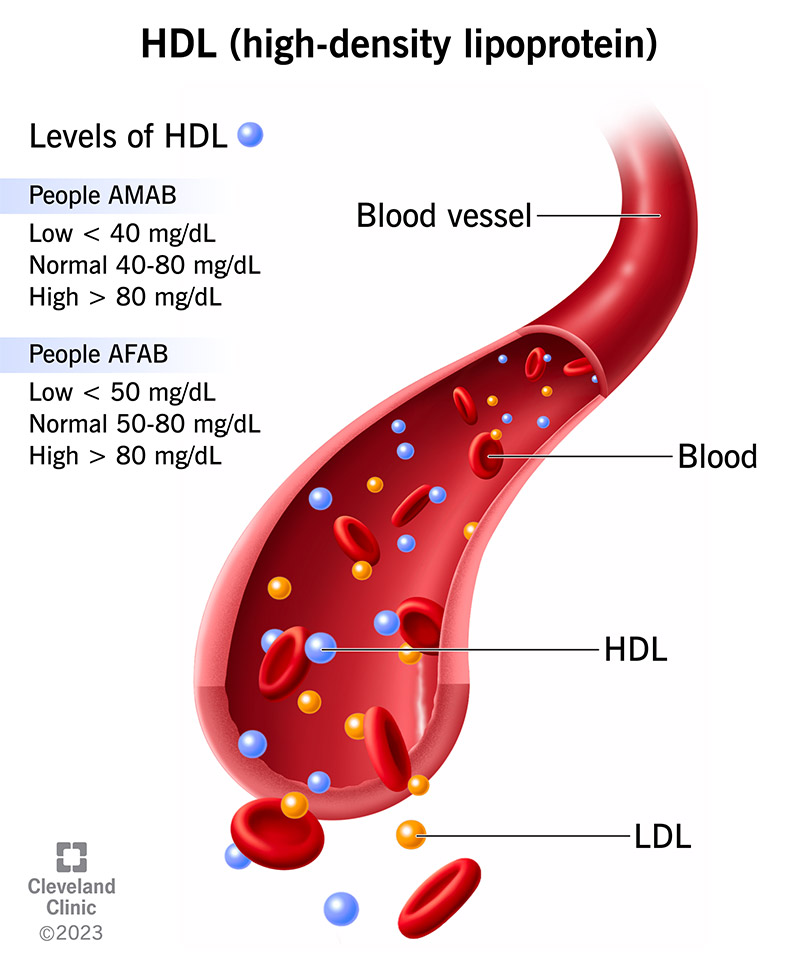HDL (high-density lipoprotein) cholesterol earned the title of “good cholesterol” because it helps you get rid of extra cholesterol. It brings it to your liver, and it ends up in your poop. A healthy amount of HDL cholesterol works against plaque buildup in arteries. This improves your risk of heart disease and stroke.

HDL stands for high-density lipoprotein. It’s a type of lipoprotein that circulates in your blood.
Lipoproteins are particles made of lipids (fats) and proteins. Their main job is to transport fats, like cholesterol, throughout your body to the cells that need them. Fats need a ride because their chemical structure keeps them from traveling solo through your blood. They need help from lipoproteins to get where they need to be.
HDL and HDL cholesterol are the same thing. Most people use both terms to talk about these particles and the role they play in your heart health.
People know HDL particles by the type of fat they carry (cholesterol), even though they contain fats and proteins.
HDL is the “good cholesterol” because it helps your body get rid of extra cholesterol. This process can lower your risk of cardiovascular disease.
Cholesterol normally travels from your liver to your bloodstream. From there, lipoproteins carry the cholesterol to different cells in your body to support important functions (like helping your body form cell membranes and produce hormones).
But sometimes, there’s too much cholesterol in your blood. It’s more than your body needs. That’s when reverse cholesterol transport helps.
Reverse cholesterol transport is a complex body process, and researchers continue to explore how and when HDL plays a role. What we know is that HDL particles can transport excess cholesterol from your bloodstream back to your liver. Your liver then breaks down this cholesterol and gets it out of your body through your poop.
This is a good thing because too much cholesterol in your blood raises your risk of plaque buildup in your artery walls (atherosclerosis).
Getting rid of extra cholesterol makes HDL the helpful cholesterol. But that’s not all it does. HDL cholesterol also works against inflammation and oxidants to keep your cells strong. And it plays a role in preventing blood clots.
Cleveland Clinic is a non-profit academic medical center. Advertising on our site helps support our mission. We do not endorse non-Cleveland Clinic products or services. Policy
Your healthcare provider can order a lipid panel blood test for you. You’ll get numbers for different kinds of cholesterol, including your HDL.
Ideally, your HDL should be 60 milligrams per deciliter (mg/dL) or higher. Research shows this can lower your risk of cardiovascular (heart and blood vessel) diseases like heart disease and stroke.
An unhealthy level of HDL cholesterol doesn’t fall within the normal range. People who have low HDL have an unhealthy level. But a level that’s too high also isn’t good because it can allow atherosclerosis to progress faster. HDL levels that are too high or low can happen because of other medical issues going on.
Normal HDL cholesterol ranges for adults vary depending on whether you’re assigned male at birth (AMAB) or assigned female at birth (AFAB).
| Low HDL Cholesterol | Normal HDL Cholesterol | High HDL Cholesterol |
|---|---|---|
| Less than 40 mg/dL for AMAB; Less than 50 mg/dL for AFAB. | 40 to 80 mg/dL for AMAB; 50 to 80 mg/dL for AFAB. | 80+ mg/dL for all. |
| Low HDL Cholesterol | ||
| Less than 40 mg/dL for AMAB; Less than 50 mg/dL for AFAB. | ||
| Normal HDL Cholesterol | ||
| 40 to 80 mg/dL for AMAB; 50 to 80 mg/dL for AFAB. | ||
| High HDL Cholesterol | ||
| 80+ mg/dL for all. |
It’s important to talk to your healthcare provider about your lipid panel results so you understand what they mean for you.
There are many reasons why your HDL cholesterol may be low, including:
An elevated, or abnormally high, HDL level is anything above 80 mg/dL.
One thing that can make your HDL cholesterol high is a genetic mutation. Some mutations to your genes can cause your body to produce too much HDL cholesterol or have trouble getting rid of it. For example, a mutation to the CETP gene can cause your HDL to be higher than 150 mg/dL.
Other causes of abnormally high HDL can include:
Your healthcare provider will investigate the cause of your elevated HDL and tell you if you need treatment.
It’s best to talk to your healthcare provider for advice tailored to your specific needs and any medical conditions you might have. In general, certain lifestyle changes can help improve your HDL level. These include:
A note from Cleveland Clinic
Making sense of your cholesterol test results can be confusing. There are many terms to learn, and it can be hard to remember which cholesterol is “good” or “bad.” When it comes to HDL, remember “h” for “helpful.” HDL cholesterol is good because it helps move extra cholesterol out of your blood. This is why healthy levels of HDL can help lower your risk for heart disease. If your HDL level isn’t where it should be, talk with your provider about ways to improve it.
Last reviewed by a Cleveland Clinic medical professional on 11/06/2023.
Learn more about our editorial process.
Cleveland Clinic is a non-profit academic medical center. Advertising on our site helps support our mission. We do not endorse non-Cleveland Clinic products or services. Policy